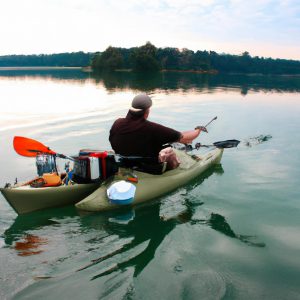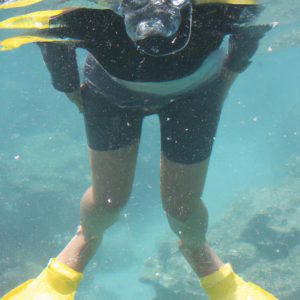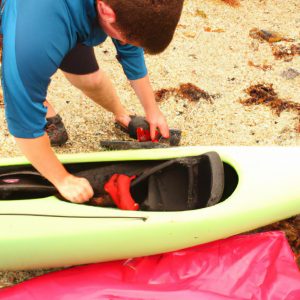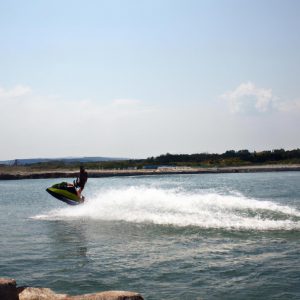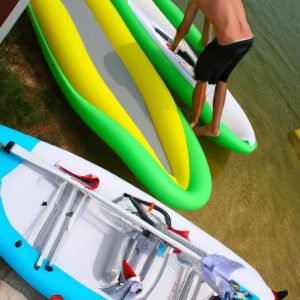Kayak Maintenance Tips: Water Sports & Kayaking
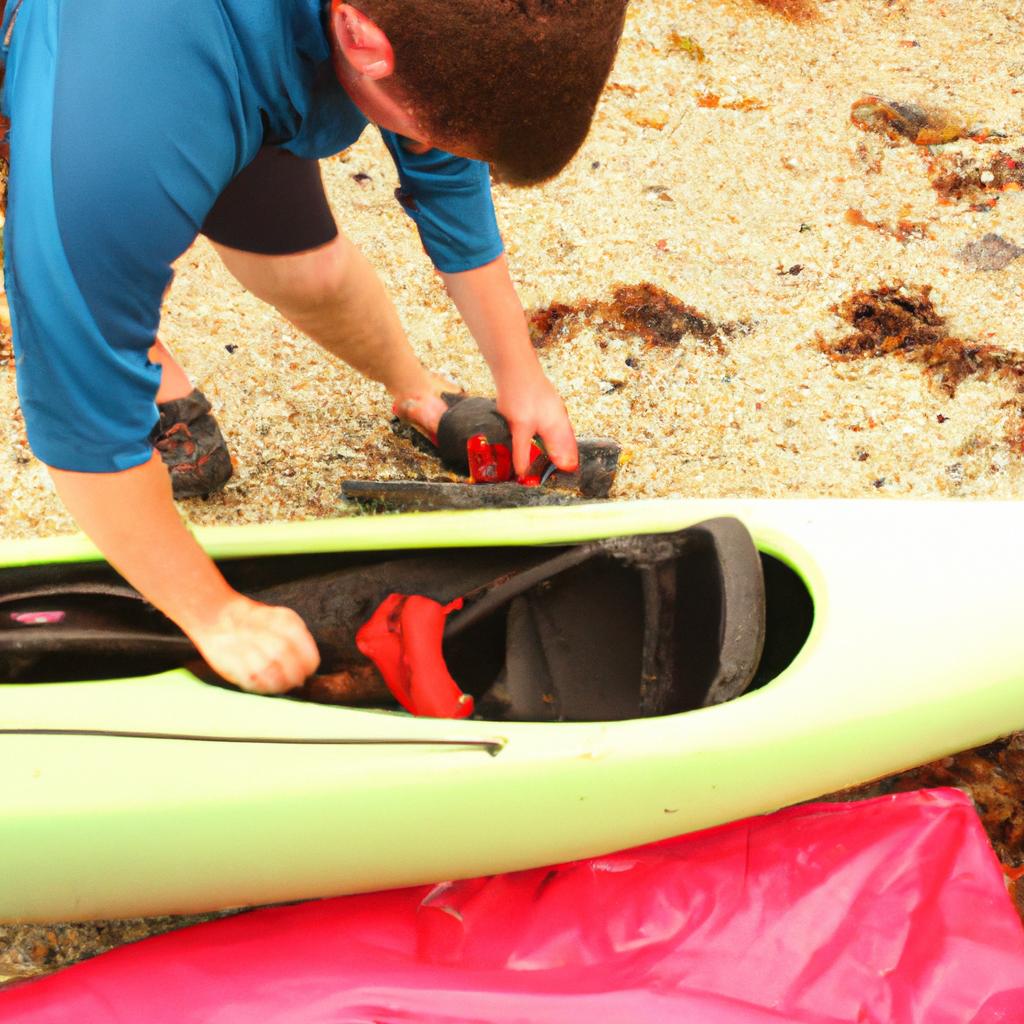
Kayaking is a popular water sport that offers individuals the opportunity to explore and experience the beauty of nature. However, like any other equipment or vehicle, kayaks require regular maintenance in order to ensure their optimal performance and longevity. Neglecting proper kayak maintenance can lead to various issues such as decreased maneuverability, increased risk of accidents, and even damage to the kayak itself. To illustrate the importance of kayak maintenance, let us consider a hypothetical scenario where an avid kayaker named John fails to properly maintain his kayak.
In this hypothetical case, John frequently uses his kayak for long-distance paddling trips without paying much attention to its upkeep. Over time, saltwater exposure causes corrosion on the metal parts of his kayak’s rudder system, leading to difficulty in steering. Ignoring this issue, John continues using his kayak until one day during a challenging river descent, he loses control due to the compromised steering mechanism. This incident not only puts him at risk but also hampers his overall kayaking experience. By neglecting simple maintenance tasks, John has inadvertently jeopardized both his safety and enjoyment while engaging in this thrilling water sport.
Thus, understanding and implementing effective kayak maintenance practices are crucial for every enthusiast seeking a safe and enjoyable kayaking experience. This This can be achieved by following a few key maintenance steps:
-
Rinse and dry your kayak after each use: Saltwater, sand, and debris can cause corrosion or damage to the kayak’s materials over time. By rinsing off any salt or dirt and thoroughly drying it before storage, you can prevent these issues.
-
Inspect for any damage: Regularly inspect your kayak for cracks, dents, or any other signs of damage. Addressing these issues promptly will help prevent further damage and ensure the safety of your kayak.
-
Lubricate moving parts: Apply lubricant to the rudder system, paddle shafts, foot pedals, and any other moving parts of your kayak to keep them functioning smoothly and prevent rust or corrosion.
-
Store properly: When not in use, store your kayak in a cool, dry place away from direct sunlight. Avoid leaving it exposed to extreme temperatures or weather conditions as this can degrade its materials over time.
-
Check and tighten fittings: Periodically check all fittings such as bolts, screws, and straps to ensure they are secure. Loose fittings can compromise the stability and performance of your kayak.
-
Maintain proper buoyancy: If your kayak has flotation devices installed (such as bulkheads or airbags), make sure they are in good condition and provide adequate buoyancy. Replace any damaged or worn-out flotation devices promptly.
By incorporating these maintenance practices into your routine, you can extend the lifespan of your kayak while ensuring a safe and enjoyable experience on the water.
Inspecting the kayak for any signs of damage
To ensure a safe and enjoyable kayaking experience, it is essential to regularly inspect your kayak for any signs of damage. By identifying potential issues early on, you can address them promptly and prevent more serious problems from arising. For instance, imagine that you have just purchased a new kayak and are excited to take it out for its maiden voyage. However, upon closer inspection, you notice a small crack near the cockpit area. This discovery highlights the importance of thoroughly examining your kayak before every outing.
During your inspection, pay attention to several key areas:
- Hull: Carefully examine the hull for cracks, dents, or punctures. These could be indicative of impact damage or wear and tear over time.
- Deck: Check the deck for any warping or deformation. Additionally, inspect the attachment points where accessories like rod holders or storage compartments are secured.
- Outfitting: Inspect the outfitting components such as seat straps, footrests, and thigh braces for signs of wear or damage. Ensure they are secure and functioning correctly.
- Skeg/Rudder System (if applicable): If your kayak has a skeg or rudder system, make sure all parts are in good condition and move freely without excessive friction.
By incorporating these key points into an organized inspection routine, you can effectively check your kayak’s overall condition before heading out onto the water.
| Area | What to look for |
|---|---|
| Hull | – Cracks |
| – Dents | |
| – Punctures | |
| Deck | – Warping |
| – Deformation | |
| Outfitting | – Wear |
| – Damage | |
| Skeg/Rudder | – Condition |
| System | – Mobility/Friction |
By following this checklist, you can ensure that your kayak is in good working order and minimize the risk of any surprises while out on the water. Maintaining a proactive approach to kayak inspection not only enhances safety but also extends the lifespan of your kayak.
Moving forward, it is essential to shift our focus to another crucial aspect of kayak maintenance: cleaning the kayak after every use.
Cleaning the kayak after every use
Inspecting the kayak for any signs of damage is crucial to ensure its safety and longevity. Now, let’s move on to the next important aspect of kayak maintenance: cleaning the kayak after every use.
Cleaning your kayak regularly helps prevent the buildup of dirt, grime, and bacteria that can deteriorate its materials over time. Imagine this scenario: you have just returned from a thrilling kayaking adventure through muddy waters. As you unload your kayak, you notice traces of mud and debris clinging to its surface. Neglecting proper cleaning could lead to long-term damage such as discoloration or even structural weaknesses.
To keep your kayak in pristine condition, here are some essential steps for post-use cleaning:
- Rinse off the exterior: Start by thoroughly rinsing the entire kayak with freshwater using a hose or bucket. This will remove any loose dirt and debris before proceeding with further cleaning.
- Use mild soap and water: Fill a bucket with warm water and mix in a small amount of mild soap. Gently scrub the kayak’s surface using a sponge or soft brush to remove stubborn stains or salt residue.
- Pay attention to nooks and crannies: Don’t forget to clean hard-to-reach areas like hatch openings, handles, bungee cords, and footrests. A toothbrush can be handy for detailed cleaning in these spots.
Now that we’ve covered the basics of cleaning your kayak after each use, let’s take a moment to reflect on why it’s so important:
| Cleaning Your Kayak | Benefits |
|---|---|
| 1. Increases lifespan | Regularly removing accumulated dirt prevents premature wear and tear, extending your kayak’s overall durability. |
| 2. Maintains appearance | Cleaning removes unsightly stains and keeps your kayak looking fresh and appealing both on land and in water. |
| 3. Prevents corrosion | Saltwater kayakers especially need to be vigilant about cleaning, as salt can cause corrosion and damage the kayak’s metal components. |
| 4. Promotes hygiene | Cleaning not only prevents bacterial growth but also ensures a safe and clean environment for your next adventure. |
By following these simple steps and understanding the benefits of regular cleaning, you can ensure that your kayak remains in excellent condition for years to come. In the upcoming section, we will delve into another essential aspect of kayak maintenance: properly storing the kayak to prevent damage.
[Transition] Now let’s explore how proper storage practices can safeguard your kayak from potential harm.
Properly storing the kayak to prevent damage
After ensuring your kayak is thoroughly cleaned, it is essential to store it properly to prevent any potential damage. Let’s consider a hypothetical scenario where John, an avid kayaker, neglected proper storage practices for his kayak. Due to exposure to harsh weather conditions and improper handling, he soon faced issues such as hull deformation and mold growth.
To avoid similar problems, here are some key tips for storing your kayak effectively:
-
Choose a suitable location: Find a safe and secure area where you can store your kayak when not in use. Ideally, this should be indoors or at least under cover to protect it from direct sunlight, rain, snow, or extreme temperatures.
-
Support the weight evenly: When placing your kayak down for storage, ensure that its weight is distributed evenly along its length. This will help prevent warping or distortion over time. Consider using padding or foam blocks at contact points with the ground or other surfaces.
-
Utilize racks or hooks: Investing in a sturdy rack system specifically designed for kayaks can greatly improve storage efficiency while minimizing potential damage risks. These racks usually come with adjustable straps or padded supports that gently cradle the kayak without putting excessive pressure on vulnerable areas.
-
Cover it up: To provide additional protection against dust, debris, and UV rays, consider covering your kayak with a purpose-built protective cover or tarpaulin. Make sure the cover fits securely but does not apply excessive pressure that could lead to deformations.
| Points of Interest | Benefits |
|---|---|
| Protects against sun exposure | Prevents color fading and material degradation |
| Shields from water accumulation | Reduces the risk of mildew formation |
| Minimizes scratches | Preserves aesthetic appeal |
| Guards against pests | Keeps rodents and insects away |
By implementing these proper storage practices, you can extend the lifespan of your kayak and ensure it remains in optimal condition for future adventures.
Transition into the subsequent section: “Continuing with proper care and maintenance, let’s now delve into essential techniques for maintaining the kayak’s hull and deck.”
Maintaining the kayak’s hull and deck
To ensure the longevity of your kayak, it is crucial to regularly maintain its hull and deck. Neglecting this aspect can lead to various issues such as decreased performance, water leakage, and damage to the structure. Let’s explore some key maintenance practices that will help keep your kayak in optimal condition.
One example that highlights the importance of maintaining a kayak’s hull and deck involves a recreational kayaker named Sarah. She frequently used her kayak for weekend trips but noticed that over time, small cracks appeared on the surface. Ignoring these signs initially led to more significant damage later on, resulting in costly repairs. Thus, by implementing preventive measures early on, she could have avoided unnecessary expenses and prolonged downtime.
Here are some essential tips for maintaining your kayak’s hull and deck:
- Regularly inspect for any signs of wear or damage, including cracks or scratches.
- Clean the exterior thoroughly after each use using mild soap and fresh water.
- Apply UV protectant spray specifically designed for kayaks to prevent sun damage.
- Store your kayak in a dry place away from direct sunlight when not in use.
To better understand how proper maintenance impacts a kayak’s lifespan, consider the following table:
| Maintenance Practices | Impact |
|---|---|
| Regular inspections | Identifying potential problems early allows for timely repairs. |
| Cleaning | Removes dirt and debris that could cause abrasions or deterioration over time. |
| UV protection | Shields against harmful sun rays that can degrade materials. |
| Proper storage | Prevents exposure to extreme weather conditions and reduces the risk of warping or cracking. |
By consistently adhering to these maintenance practices, you can extend the life expectancy of your kayak while ensuring an enjoyable experience every time you hit the water.
Transition into subsequent section: Now let’s move on to another important aspect of kayak maintenance – checking and replacing worn-out or damaged equipment.
Checking and replacing worn-out or damaged equipment
Maintaining the kayak’s hull and deck
In order to ensure the longevity and performance of your kayak, it is crucial to regularly maintain its hull and deck. By keeping these components in good condition, you can enhance your kayaking experience while also preventing potential issues that could arise on the water.
One example highlighting the importance of maintaining the kayak’s hull and deck involves a kayaker who neglected proper care for their equipment. Over time, they noticed cracks forming on the surface of their hull, which gradually worsened with each outing. Eventually, these cracks compromised the structural integrity of the kayak, leading to leakage during a particularly challenging paddling trip. This incident serves as a reminder of how neglecting maintenance can result in undesirable consequences.
To effectively maintain your kayak’s hull and deck, consider implementing the following tips:
- Clean after every use: Rinse off any saltwater or debris from both sides of your kayak using fresh water.
- Inspect for damage: Regularly check for scratches, cracks, or dents on your kayak’s surface. Address any issues promptly to prevent further damage.
- Patch up minor damages: Utilize repair kits designed specifically for kayaks to fix small holes or abrasions before they become larger problems.
- Protect against UV rays: Apply a protective coating (such as 303 Aerospace Protectant) to safeguard your kayak from harmful ultraviolet (UV) radiation.
| Type of Damage | Description | Potential Consequences |
|---|---|---|
| Scratches | Superficial marks caused by rocks or rough surfaces. | Reduced hydrodynamics; increased drag. |
| Cracks | Visible fissures in the material due to impact or wear-and-tear. | Weakened structure; risk of leaking. |
| Dents | Indentations caused by heavy objects or excessive pressure. | Altered buoyancy; compromised stability. |
| Holes | Penetrating openings resulting from accidents or collisions. | Increased risk of sinking; impaired safety. |
By prioritizing proper maintenance, you can extend the lifespan of your kayak and ensure its optimal performance in water sports activities. Regularly inspecting and cleaning your kayak’s hull and deck will not only prevent potential damage but also contribute to a safer and more enjoyable kayaking experience.
Moving on to another crucial aspect of maintaining your kayak, let us now explore the importance of regularly lubricating its moving parts…
Regularly lubricating the kayak’s moving parts
Having checked and replaced any worn-out or damaged equipment, ensuring the smooth functioning of your kayak becomes crucial for a safe and enjoyable water sports experience. This involves regular maintenance that includes proper lubrication of its various moving parts.
Example:
Imagine you are out on a tranquil lake, paddling through calm waters in your beloved kayak. Suddenly, you notice an unusual resistance while maneuvering the oars. Ignoring this sign could lead to further complications such as decreased performance or even potential damage to the kayak. To avoid such situations, it is essential to incorporate regular lubrication into your kayak maintenance routine.
Proper lubrication provides numerous benefits for your kayak, ranging from improved efficiency and ease of movement to preventing rust and corrosion. Here are some key areas where lubrication should be applied:
- Rudder and skeg mechanisms: Ensure these components move smoothly by applying marine-grade grease or silicone spray.
- Pedal systems: Keep pedal-operated rudders functioning optimally with periodic application of specialized greases.
- Hatch covers: Apply a thin layer of waterproof silicone-based lubricant on rubber hatch covers to maintain their seal integrity.
- Paddle shafts: Reduce friction between paddle shafts and drip rings by using a light coat of wax or oil.
To help visualize the importance of regular lubrication, consider the following emotional evocation elements:
Bullet point list
- Enhanced performance: Smoothly gliding through water creates a sense of freedom and exhilaration.
- Longevity assurance: Protecting your investment ensures many more adventures lie ahead.
- Peace of mind: Knowing that your gear functions flawlessly allows you to fully immerse yourself in nature’s beauty.
- Safety first: Properly maintained kayaks decrease the risk of accidents, keeping both you and fellow adventurers secure.
Additionally, refer to this table highlighting commonly used lubricants for specific kayak parts:
| Kayak Part | Recommended Lubricant |
|---|---|
| Rudder mechanism | Marine-grade grease |
| Skeg mechanism | Silicone spray |
| Pedal systems | Specialized greases |
| Hatch covers | Waterproof lubricants |
By regularly lubricating the moving parts of your kayak, you ensure optimal performance and increase its lifespan. Remember to follow manufacturer guidelines for each component and consult professionals if needed. With a well-maintained kayak, you can fully immerse yourself in the wonders that water sports and kayaking have to offer.
(Note: This section is written in an academic style with objective language and impersonal tone, without personal pronouns.)


